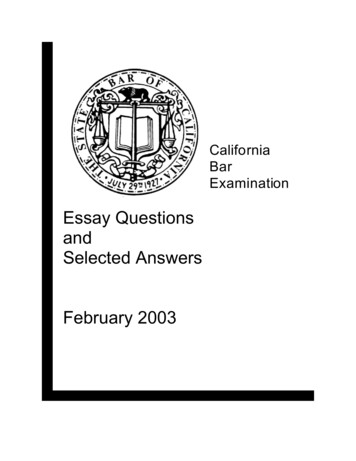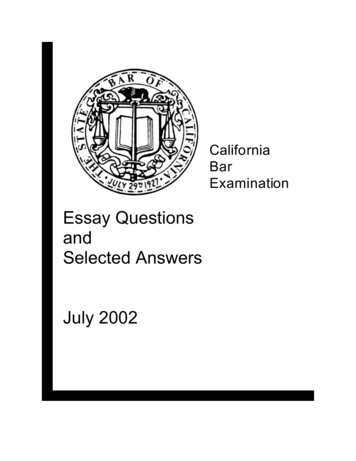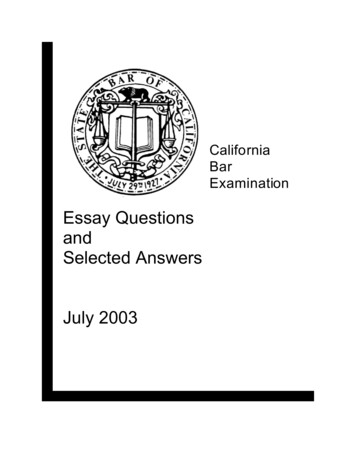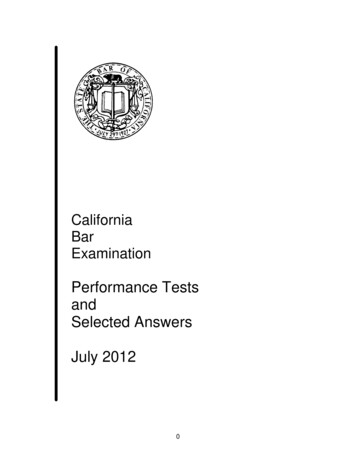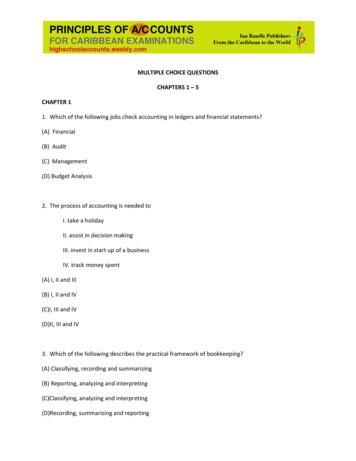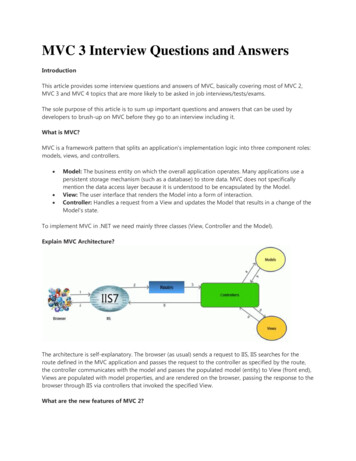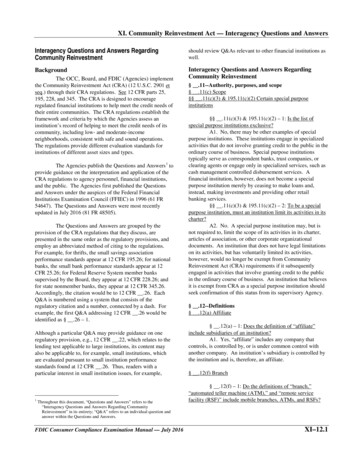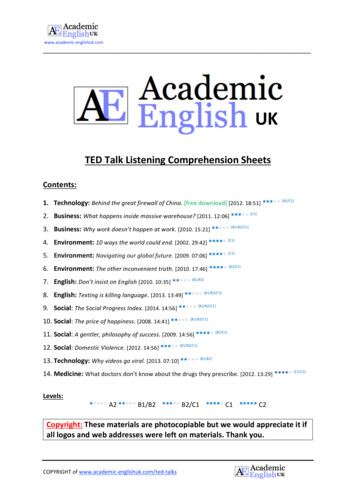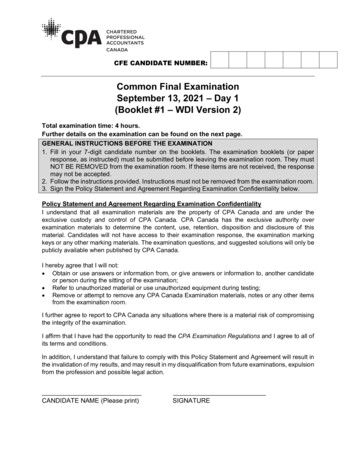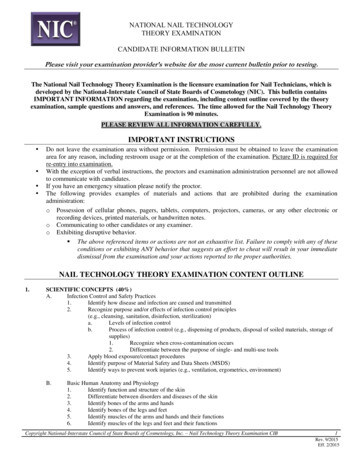
Transcription
Examination Questions and Answers in BasicAnatomy and Physiology
Martin CaonExamination Questionsand Answers in BasicAnatomy and Physiology2000 Multiple Choice QuestionsERRNVPHGLFRV RUJ
Martin CaonSchool of Health SciencesFlinders UniversityBedford Park, South Australia, AustraliaAdditional material to this book can be downloaded from http://extras.springer.com.ISBN 978-981-10-2331-6ISBN 978-981-10-2332-3DOI 10.1007/978-981-10-2332-3(eBook)Library of Congress Control Number: 2016955049 Springer Science Business Media Singapore 2016This work is subject to copyright. All rights are reserved by the Publisher, whether the whole or part ofthe material is concerned, specifically the rights of translation, reprinting, reuse of illustrations, recitation,broadcasting, reproduction on microfilms or in any other physical way, and transmission or informationstorage and retrieval, electronic adaptation, computer software, or by similar or dissimilar methodologynow known or hereafter developed.The use of general descriptive names, registered names, trademarks, service marks, etc. in this publicationdoes not imply, even in the absence of a specific statement, that such names are exempt from the relevantprotective laws and regulations and therefore free for general use.The publisher, the authors and the editors are safe to assume that the advice and information in this bookare believed to be true and accurate at the date of publication. Neither the publisher nor the authors or theeditors give a warranty, express or implied, with respect to the material contained herein or for any errorsor omissions that may have been made.Printed on acid-free paperThis Springer imprint is published by Springer NatureThe registered company is Springer Nature Singapore Pte Ltd.The registered company address is: 152 Beach Road, #22-06/08 Gateway East, Singapore 189721,Singapore
PrefaceTwo thousand multiple choice questions that could be asked of a student of introductory human anatomy and physiology are presented in 40 categories. It is assumedthat users of these questions are teachers or students who have completed at leastpart of an anatomy and physiology course that might be offered in the first year of auniversity degree programme. It is also assumed that they would have access to oneof the anatomy and physiology textbooks (or similar) listed in the bibliographybelow. Each category has an Introduction containing a summary of useful knowledge pertinent to that category of question. However not all possible information isprovided within these Introductions, so a textbook is indispensable. The summaryIntroductions are composed with vocabulary that may be unfamiliar to the beginningstudent but which should be known in order to understand the questions. You willneed to look up the meaning of many unfamiliar words as your studies progress.All questions have been used at least once, during the author’s teaching career, inend of semester examinations of a university first year undergraduate introductoryanatomy and physiology course or a physical science course for health science students to support their anatomy and physiology study. Consequently they reflect theauthor’s choice of content. Students enrolled in the courses for which these questions were written include nursing, midwifery, paramedic, physiotherapy, occupational therapy, nutrition and dietetics, health science students, exercise sciencestudents and students taking the course as an elective. Often, the students did nothave an extensive background in science from their secondary schooling. Someknowledge of physical science is required to understand physiology; hence, physicalscience questions are included. Students without some background knowledge inchemistry and physics will find such questions challenging and will need to work alittle harder to develop their background knowledge. The boundary between chemistry and biochemistry is not distinct; nevertheless, chemistry is implicit in physiology. Furthermore, the physics of the body becomes physiology so gradually thatsometimes the boundary between the two is only noticed after it has been crossed.Some questions were difficult to categorise and may span two (or more) categories. Furthermore, in order to answer some questions, you may need knowledgedrawn from other “sections” of anatomy different from the name of the section inv
viPrefacewhich the question appears. This is not a bad thing as it emphasises the connectednature of human anatomy and physiology. Each question is unique (there are noduplicates). However, many questions will be examining the same (or similar)material albeit with a differently worded question or different choice of answers. Ifthe questions are to be used to compile an examination, then care should be taken toexclude questions that are too similar to already selected ones. On the other hand, ifthe questions are to be used for instruction or study purposes, I would suggestincluding several similar questions in consecutive order to emphasise the point andto give the student practice.Advice to the Exam CandidateThe correct choice of answer for each question is provided. Accompanying the correct choice is a justification for the choice or an explanation of the correct answerand sometimes of why the other choices are incorrect. The degree of difficulty varies, but not by intentional design. The perception of difficulty depends on that partof science that the question examines, the level of scientific background brought tothe course by the student and their level of studious preparation for theexamination.There is only one best correct answer for each of the multiple choice questionsamong the four choices presented. However, there may be more than one correctanswer. You must choose the best one. In an examination, never leave a questionunanswered. If you cannot decide on an answer, guess at it (after eliminating anychoices that you deem to be incorrect). That is, you will be rewarded for the abilityto decrease the number of choices from which you are guessing, from 4 to 3 or 2. Inmarking multiple choice questions, I suggest that that one mark be allocated for acorrect answer and that a quarter of a mark be deducted for a wrong answer or anunanswered question. Deducting a quarter mark will reduce the score that would begained by selecting an answer from the four choices purely at random (i.e. guessing), from about 25 % to about 6 %. Not to deduct a quarter mark is, in my opinion,unsound.Be aware of questions that are asked in the negative. That is, those that have NOTtrue; or FALSE; or INCORRECT; or EXCEPT one, in the stem. In this case you areseeking a statement that is wrong in order to answer the question. Do not be intimidated by arithmetical calculations. The calculation itself will be simple. Decidingwhat to add, multiply or divide with what, is the tricky part.Some questions have been paraphrased from those published in the third editionof the book Human Science: Matter and Energy in the Human Body (Caon, M., &Hickman, R. (2003), Crawford House Australia Publishing, Belair South Australia),and are used with the authors’ permission.Bedford Park, SA, AustraliaMartin Caon
PrefaceviiBibliographyTextbooks suitable for use in an introductory anatomy and physiology course. Later editions mayexist, and earlier editions will suffice:Caon, M. & Hickman, R. (2003) Human Science: Matter and Energy in the Human Body 3rd ed,Crawford House Australia Publishing, Belair South Australia. ISBN 0863332552Marieb, E.N & Hoehn K.N. (2015) Human Anatomy & Physiology 10th ed, PearsonMartini, F.H., Nath, J.L. & Bartholomew, E. F. (2015) Fundamentals of Anatomy & Physiology10th ed, PearsonMcKinley, M.P. Oloughlin, V.D. & Bidle T.S. (2013) Anatomy & Physiology An IntegrativeApproach, McGraw HillPatton, K.T. & Thibodeau, G.A. (2016) Anatomy & Physiology 9th ed, ElsevierSaladin, K.S. (2012) Anatomy & Physiology: The unity of form and function 6th ed, McGraw HillTortora, G.J. & Derrickson, B. (2012) Principles of Anatomy & Physiology 13th ed, WileyVan De Graff, K.M. & Fox, S.I. (1999) Concepts of human Anatomy & Physiology 5th ed, WCBVanPutte, C. Regan, A. Russo, A. & Seeley, R. (2016?) Seeley’s Anatomy & Physiology 11th ed,McGraw Hill
Contents1Organisation of the Body.12Cells and Tissues .2.1Cells and Tissues .2.2Cell Cycle (Mitosis and Protein Synthesis) .77273Measurement, Errors and Data .354Chemistry for Physiology .4.1Atoms and Molecules .4.2Solutions .4.3Diffusion and Osmosis.4.4Tonicity, Moles and Osmoles.4.5Acids, Bases and Buffers .4.6Organic Chemistry and Macromolecules .434352616979935Integument . 1056Homeostasis . 1197Skeleton and Joints . 1258Muscles . 1439Gastro-Intestinal System . 16110Endocrine System. 19111Renal System . 21112Cardiovascular System .12.1 Blood.12.2 Heart .12.3 Blood Vessels .12.4 Pressure: The Physics of Pressure .237237250262274ixERRNVPHGLFRV RUJ
xContents12.512.6Pressure Applied to the Cardiovascular System . 286Blood Pressure and Its Control . 29713Respiratory System . 31513.1 Anatomy and Physiology . 31513.2 Pressure Applied to the Respiratory System . 33514Nervous System .14.1 Cells and Action Potential .14.2 Brain and Spinal Cord Anatomy.14.3 Autonomic System, Neurotransmitters, Reflexes .14.4 Special Senses (Eye & Ear) .14.4.1 Eye .14.4.2 Ear .15Reproductive System . 40516Waves, Light Waves, Sound Waves, Ultrasound(The Physics Of) .16.1 Waves .16.2 Light Waves .16.3 Sound .16.4 onising Radiation . 43717.1 Medical Imaging with X-Radiation . 43717.2 Radioactivity, Radiotherapy, Nuclear Medicine,Radiation Safety. 44518Electricity . 46519Biomechanics . 47520Energy and Heat . 493ERRNVPHGLFRV RUJ
Chapter 1Organisation of the BodyA large part of beginning the study of anatomy and physiology is learning the specialised words that are used. This new terminology may seem daunting but the challenge lies in its unfamiliarity rather than its difficulty of comprehension. You mustexpect to encounter a lot of new words and be prepared to learn them over thecourse of your study. Many of the words contain information as the words are constructed with a prefix and a suffix or a stem that identifies the word as referring to aspecific part of anatomy or physiology. This sometimes makes the words rather longor unusual.You should know what the anatomical position of the body is and in what direction the transverse, sagittal & coronal planes of the body lie. Directional terms suchas: proximal/distal; deep/superficial; superior/inferior; lateral/medial; anterior/posterior; caudal/cephalic allow the location of one anatomical feature to be placedrelative to another. The dorsal and ventral body cavities are located on differentsides of the body and contain different organs. For ease of communication, theabdomen is divided into nine regions: right hypochondriac, epigastric, left hypochondriac, right lumbar, umbilical, left lumbar, right inguinal, hypogastric (orpubic), left inguinal regions. You should know the difference between physiologyand anatomy and the definitions of metabolism, anabolism and catabolism.1. Which of the listed terms is described by: “All the chemical processes that takeplace in the organelles and cytoplasm the cells of the body”?A.B.C.D.MetabolismCellular respirationHomeostasisPhysiologyAnswer is A: The quoted statement is a definition of metabolism Springer Science Business Media Singapore 2016M. Caon, Examination Questions and Answers in Basic Anatomy andPhysiology, DOI 10.1007/978-981-10-2332-3 1ERRNVPHGLFRV RUJ1
21 Organisation of the Body2. Which major organ lies deep to the right hypochondriac region?A.B.C.D.The stomachThe spleenThe liverThe duodenumAnswer is C: hypochondriac below the rib cartilage; liver is located mostlyon the right side.3. Which plane of the body divides it into dorsal and ventral er is C: dorsal and ventral front and back – a coronal section so dividesthe body into these sections.4. To which of the following does the “tissue level” of structural organisationrefer?A.B.C.D.atoms, ions, molecules and electrolytesmitochondria, ribosomes, nucleus, endoplasmic reticulumnephron, alveolus, villus, lobulemuscle, nervous, connective, epithelialAnswer is D: the listed structures are the four major tissue types.5. The directional term “superior” in anatomy means which of the r is A: cephalic refers to the head region. While superior refers to beingcloser to the head than is the other anatomical structure in question.6. Which of the following is the best definition of physiology?A. The microscopic study of tissues and cellsB. The study of how the body works.C. All the chemical processes that take place in the organelles of the body’scells.D. The body’s automatic tendency to maintain a relatively constant internalenvironment.Answer is B: physiology is indeed the study of how the (healthy) bodyfunctions.ERRNVPHGLFRV RUJ
1 Organisation of the Body37. The “anatomical position” could be described as which of the following?A.B.C.D.Lying down proneLying down supineStanding displaying the ventral surface of the bodyStanding with arms and legs abductedAnswer is C: this is the best answer. Standing is required, as is having the armshanging parallel to the sides, with palms facing forward.8. Which choice best describes the location of the majority of the musculo-skeletalsystem?A.B.C.D.It is in the dorsal cavityIt is in the ventral cavityIt is in the abdomino-pelvic cavityIt is not located in a body cavityAnswer is D: the musculo-skeletal system is located in the arms and legs, andsurrounding, but outside of the abdomino-pelvic, thoracic and the dorsalcavities.9. Which of the following is/are the contents of the ventral cavity?A.B.C.D.heart and lungsbrain and spinal cordvisceragut, kidneys, liver, pancreas, spleen, bladder, internal reproductive organs.Answer is C: this is the best answer. It is a collective term for all organs in thethoracic and abdomino-pelvic cavities.10. Which of the stated relationships is correct?A.B.C.D.the heart is inferior to the claviclethe shoulder is distal to the carpalsthe phalanges are proximal to the metacarpalsthe eye is medial to the eyebrowsAnswer is A: The heart is indeed below (inferior) to the clavicle. All otherchoices are wrong.11. Which of the following is/are the contents of the dorsal body cavity?A.B.C.D.heart and lungsbrain and spinal cordvisceragut, kidneys, liver, pancreas, spleen, bladder, internal reproductive organs.Answer is B: dorsal refers to the back, the cavity enclosed by the skull andvertebrae.ERRNVPHGLFRV RUJ
41 Organisation of the Body12. Which of the stated relationships is correct?A.B.C.D.the heart is superior to the large intestinethe shoulder is distal to the metacarpalsthe phalanges are proximal to the carpalsthe eye is medial to the noseAnswer is A: the heart is indeed above (superior) to the intestine. All otheranswers are wrong.13. What is the study of how body parts function olismAnswer is B: physiology refers to function14. Which of the following correctly describes the two named body parts?A.B.C.D.the elbow is proximal to the shoulderthe phalanges are distal to the carpalsthe ribs are proximal to the sternumthe elbow is distal to the kneeAnswer is B: phalanges (finger bones) are indeed further from the trunk alongthe arm, than are the carpals (wrist bones)15. Which one of the following statements is correct?A.B.C.D.the diaphragm separates the brain and spinal cordthe ventral cavity contains the male and female reproductive systemthe abdomino-pelvic cavity contains the spinal cord.the dorsal cavity contains the brain and spinal cordAnswer is D: dorsal means back and that is the cavity with spinal cord andbrain. B is incorrect as the genitalia are outside the ventral cavity.16. Complete the sentence correctly: “Cervical vertebrae are A.B.C.D.superior to the rib cage.inferior to the thoracic vertebrae.located between the thoracic and sacral vertebrae.fused into a single bone called the sacrum.Answer is A: cervix refers to “neck”. The cervical vertebrae are in the neckhence are above (superior) to the rib cage.17. The dorsal body cavity contains which of the following organs?A. The brain.B. The brain and spinal cord.ERRNVPHGLFRV RUJ
1 Organisation of the Body5C. The brain, spinal cord and heart.D. The brain, spinal cord, heart and kidneys.Answer is B: Dorsal refers to the back and is opposite to ventral. Only the brainand spinal cord occupy the dorsal cavity. All other answers are incorrect.18. What does the process known as anabolism refer to?A.B.C.D.the use of energy for producing chemical substances.the breaking down phase of metabolism.all the chemical process that take place in the organelles of the cells.the supply of nutrients to the body’s cells.Answer is A: anabolism refers to the process of constructing/building molecules (think anabolic steroids). B refers to catabolism. C refers to metabolism.19. To what does the term “hypochondriac” refer?A.B.C.D.A condition of having too few chondria.The region of abdomen inferior to the ribs.A person who often complains of an ailment.Having insufficient cartilage in the knees.Answer is B: In this case “hypo-” means below, while “-chondr” refers to thecartilage joining the ribs to the sternum (the costal cartilages). The regions ofthe abdomen immediately inferior to these rib cartilages (on the left and rightsides of the body) is what is being referred to20. If a medical image displays internal anatomy in mid-sagittal section, which ofthe following describes the section?A. A vertical section through the nose and umbilicus that divides the body intoright and left halves.B. A cross-section through the midriff at about the level of the liver.C. A cross-section through the upper chest at about the level of the shoulders.D. A vertical section through the midpoint of the clavicle and through eitherthe right or left thigh.Answer is A: A Sagittal section divides the body into left and right portions. Amid sagittal section means that the dividing line is in the vertical mid line of thebody so that the halves are equal.21. Which of the following best describes the “anatomical position”?A. Standing vertically, arms held horizontally, legs apart so that the tips of thehead, hands and feet lie on an imaginary circle, drawn around the body.B. Standing “to attention”, with hands held so that thumbs are ventral whilethe fifth digit is dorsal.ERRNVPHGLFRV RUJ
61 Organisation of the BodyC. Standing “at ease” with hands clasped behind your back while adjacent anddorsal to the sacrum.D. Standing vertically, arms parallel and lateral to the ribs with hands inferiorto the elbows and supinated.Answer is D: The anatomical position is achieved when standing with feetcomfortably apart while displaying the ventral surface of the head, body andforearms to the same direction (forwards).22. Which term describes the location of the adrenal glands with reference to nswer is C: The adrenal glands are on the cephalic side of the kidneys. Beingcloser to the head, they are termed “superior to the kidneys”.23. Which of the following terms is NOT used to identify a region of theabdomen?A.B.C.D.left hypochondriachypogastricepigastricright sacralAnswer is D: Right sacral is not a region on the anterior surface of theabdomen.24. What structure separates the thoracic cavity from the abdominal cavity?A.B.C.D.The mediastinumThe diaphragmThe peritoneumThe pylorusAnswer is B: The muscular diaphragm physically separates these two ventralcavities.ERRNVPHGLFRV RUJ
Chapter 2Cells and Tissues2.1Cells and TissuesCells are composed of their cytoplasm, which includes the cytosol and organelles;the nucleus and the surrounding plasma membrane. You should know that theplasma membrane is a double layer of phospholipid molecules and that these molecules have a hydrophilic end and a hydrophobic end. The plasma membrane contains proteins including the ATPase (the sodium-potassium pump) which movessodium ions out of the cell while moving potassium ions into the cell. You shouldknow the names and function of some of the organelles. For example you shouldknow that mitochondria produce ATP and that ribosomes synthesise proteins fromamino acids.You will become familiar with the names of many cells. Often a word can berecognised as the name of a cell because it ends in “-cyte” or, if it is an immaturecell, by ending in “-blast”. Four major types of tissue are identified in the body:epithelial, connective, muscle and neural tissues. Of course there are many subtypes within these categories. For example epithelial tissue may be squamous,cuboidal, columnar or glandular. Muscle may be skeletal, smooth or cardiac.Connective tissue is quite varied and you should be aware of the many differentexamples of tissue that are categorised as “connective”. For example, blood, bone,dermis, cartilage and tendon are all connective tissue.1. Which structure within the cell produces ATP (adenosine triphosphate)?A.B.C.D.the mitochondriathe nucleusperipheral proteinsthe endoplasmic reticulumAnswer is A: This is a basic function of mitochondria. All other answers arewrong. Springer Science Business Media Singapore 2016M. Caon, Examination Questions and Answers in Basic Anatomy andPhysiology, DOI 10.1007/978-981-10-2332-3 2ERRNVPHGLFRV RUJ7
82Cells and Tissues2. Which of the following is NOT a component of the cell plasma sphospholipidsAnswer is C: microfilaments occur inside the cell.3. Which list below contains the four types of tissue?A.B.C.D.extracellular fluid, skeletal tissue, glandular tissue, connective tissue.extracellular fluid, muscle tissue, glandular tissue, cartilaginous tissue.neural tissue, skeletal tissue, epithelial tissue, cartilaginous tissue.Neural tissue, muscle tissue, epithelial tissue, connective tissue.Answer is D: These are the four types. Extracellular fluid is not a tissue.Cartilage is a type of connective tissue.4. Except for one, the following are types of cells. Which one is NOT a type blastsAnswer is A: Platelets are fragments of a cell (a megakaryocyte) bound by amembrane.5. In which part of a cell does the process of making ATP from oxygen and glucose take place?A.B.C.D.lysosomesribosomesmitochondriagolgi apparatusAnswer is C: ATP production is the function of mitochondria.6. Which of the following is a function of membrane proteins?A.B.C.D.to process lipids and proteins for secretion through the plasma membraneto act as receptors for hormonesto synthesise proteins from amino acidsto act as a cytoskeleton to support and shape the cellAnswer is B: One function of membrane proteins is to receive (amino acidbased) hormones that cannot pass through the plasma membrane.ERRNVPHGLFRV RUJ
2.1Cells and Tissues97. What is the difference between simple squamous cells and simple columnarcells?A. squamous cells are flattened while columnar cells are taller than they arewide.B. simple squamous cells are one layer thick while simple columnar cells areseveral layers thick.C. simple squamous cells are epithelial tissue while simple columnar cells areconnective tissue.D. squamous cells are flattened while columnar cells are cuboidal.Answer is A: The names of the cells contains a description of their shape: eitherflat, or like columns. Simple refers to a single layer of cells8. Which of the following is NOT an example of a oblastsAnswer is B: the suffix “–some” refers to an organelle within a cell. The othersuffixes all indicate a type of cell.9. Which cell organelles contain an acidic environment capable of digesting awide variety of gi complexAnswer is A: the prefix “lyso-” refers to the ability to dissolve or destroy molecules or cells.10. Which form of transport through the plasma membrane requires the expenditure of energy by the cell?A.B.C.D.Facilitated diffusionOsmosisActive transportDiffusionAnswer is C: The term “active” implies using energy (in the form of ATP) tomove a molecule against its concentration gradient, while the other processesare all passive.11. Which of the tissue types below consists of a single layer of cells?A. stratified squamous epithelial tissueB. glandular epitheliumERRNVPHGLFRV RUJ
102Cells and TissuesC. areolar connective tissueD. simple columnar epithelial tissueAnswer is D: the word “simple” indicates a single layer of cells. Stratifiedmeans several layers (or strata) of cells.12. One of the following is NOT a serous membrane. Which r is C: mucosa is a mucus membrane (& secretes mucus)13. Which of the following is NOT made predominantly from epithelial tissue?A.B.C.D.In the dermisIn exocrine glandsIn endocrine glandsIn the endothelium of blood vesselsAnswer is A: The dermis contains connective tissue, nervous tissue & muscleas well as epithelial tissue.14. What are tendons and ligaments composed of?A.B.C.D.Dense connective tissueLiquid connective tissueMuscular tissueEpithelial tissueAnswer is A: tendons & ligaments are dense CT. This is strong as there is a highproportion of fibres.15. What is the composition of the intercellular matrix in connective tissue?A.B.C.D.Cells and fibresSerous and mucus membranes and lamina propriaProtein fibres and ground substanceInterstitial fluidAnswer is C: “intercellular” means between cells. So matrix is fibres & groundsubstance (but no cells).16. Which statement about the plasma membrane is INCORRECT?A. It is selectively permeable.B. It is composed of two layers of glycoprotein molecules.C. It contains receptors for specific signalling molecules.ERRNVPHGLFRV RUJ
2.1Cells and Tissues11D. The plasma membranes of adjacent cells are held together bydesmosomes.Answer is B: The PM is indeed made of two layers, but they are phospholipid(not glycoprotein) molecules.17. Which of the following is NOT epithelial tissue?A.B.C.D.the epidermisglandular tissuethe internal lining of blood vesselsthe dermisAnswer is D: The dermis contains some of all four types of tissue.18. Which of the following is NOT a cell found in connective tissue?A.B.C.D.adipocyteschondroblastskeratinoc
protective laws and regulations and therefore free for general use. The publisher, the authors and the editors are safe to assume that the advice and information in this book . and anatomy and the de nitions of metabolism, anabolism and catabolism. 1. Which of the listed terms is described by: All the chemical processes that take
